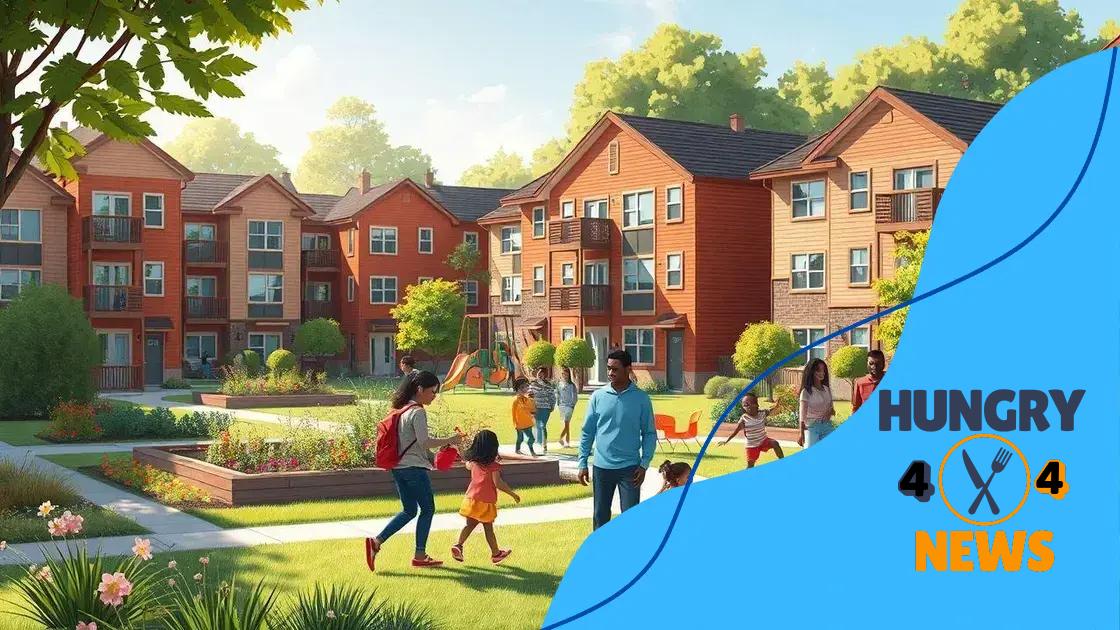Homelessness prevention and affordable housing strategies

Homelessness prevention and affordable housing strategies focus on providing stable housing, healthcare access, and community support to reduce homelessness and improve overall quality of life.
Homelessness prevention and affordable housing strategies are crucial in shaping communities. Have you ever wondered how these approaches can change lives and restore dignity? Let’s delve into this important subject.
Understanding homelessness and its causes
Understanding homelessness is essential to addressing its root causes. Many factors contribute to this complex issue, making it vital to explore these elements carefully.
One significant factor is the lack of affordable housing. In many cities, the rent prices have skyrocketed, displacing numerous families. Homelessness often arises when individuals cannot find a stable living situation.
Economic Factors
Poverty plays a critical role in homelessness. When people lack sufficient income, they struggle to secure basic needs. Unemployment can push families into precarious circumstances, increasing homelessness rates.
Health Issues
Moreover, mental health and substance abuse problems can lead to homelessness. Many individuals facing these challenges find it difficult to maintain stable employment or housing. Support systems are often lacking, making recovery difficult.
- Lack of access to healthcare services
- Inability to afford medications
- Stigma associated with mental health
- Limited resources for rehabilitation
Finally, systemic issues, such as discrimination and social inequality, contribute significantly. Marginalized groups often face barriers in employment and housing, exacerbating their risk of homelessness.
By recognizing these causes, we can develop comprehensive strategies to prevent homelessness and provide support where it is most needed. Understanding these elements enables communities to come together and create effective solutions.
Key strategies for preventing homelessness
Key strategies for preventing homelessness focus on providing support at various levels. One effective method is ensuring that affordable housing is accessible to all. When housing options are available, families are less likely to face displacement.
Financial assistance programs can help those in need maintain their homes. Subsidies and rental assistance can alleviate financial burdens, enabling families to stay in their residences even during tough times.
Comprehensive Support Services
Implementing comprehensive support services is crucial. These services can include job training and mental health support. By helping individuals gain employment and manage their health, communities can reduce homelessness.
- Job readiness programs
- Counseling services for families
- Substance abuse rehabilitation
- Access to healthcare
Education is another vital factor. Increasing awareness about financial literacy can empower individuals to make informed decisions. With better knowledge, people can budget effectively and avoid falling into crisis.
Community Engagement
Community engagement plays a key role in preventing homelessness. Local organizations can mobilize resources and create initiatives to support vulnerable populations. Collaborative efforts among government agencies, non-profits, and community members can lead to sustainable solutions.
Finally, creating a safety net through policy measures can strengthen efforts against homelessness. Advocating for fair housing policies ensures that discrimination does not lead to homelessness. By supporting policies that favor affordable housing development, communities can combat this issue effectively.
The role of affordable housing in communities

The role of affordable housing in communities is vital for fostering stability and growth. When people have access to affordable homes, they become empowered to build better lives. This crucial resource helps individuals and families maintain security and prevent homelessness.
Affordable housing promotes economic diversity within a community. It allows people from various socioeconomic backgrounds to live and work together. This blend creates a vibrant environment where diverse ideas can flourish, benefiting everyone.
Impact on Crime Rates
Communities with adequate affordable housing often experience lower crime rates. When families feel safe and secure in their homes, they are more likely to engage positively with their neighbors. As a result, neighborhoods become stronger and more cohesive, fostering a sense of community.
- Stronger community ties reduce isolation.
- Engagement in local events creates connections.
- Opportunities for youth programs increase.
- Support networks become more robust.
Moreover, stable housing leads to better health outcomes. Families living in secure environments can access healthcare services and avoid the stress associated with unstable living conditions. Children raised in these homes also achieve better educational outcomes. They can focus on studies rather than worrying about where to sleep.
Economic Benefits
Affordable housing also contributes to local economies. When families spend less on housing, they have more disposable income for other needs. This increased spending can stimulate local businesses, creating jobs and fostering growth.
Furthermore, investment in affordable housing can enhance property values in the long run. Areas that are well-maintained and have a mix of housing options attract more residents and businesses. This dynamic not only strengthens the community but also enhances the overall quality of life.
Success stories from effective programs
Success stories from effective programs can shine a light on the impact of homelessness prevention initiatives. These examples show what can happen when communities come together to tackle this pressing issue.
Programs that focus on providing affordable housing and supportive services often lead to positive outcomes. For instance, in cities like Houston, Texas, a collaborative effort known as “The Way Home” has helped reduce homelessness by combining housing assistance with health and job support.
Case Study: The Way Home
This program demonstrates how systematic approaches can make a difference. By connecting individuals with needed resources, they have transformed lives. Many participants report increased stability and improved mental health. With access to employment training, these individuals gain the skills necessary to secure jobs and sustain their housing.
- Over 25,000 people were transitioned into permanent housing.
- Participants showed significant improvement in quality of life.
- Community partnerships amplified resources and support.
- Job placement programs were critical to success.
Another example comes from the “Rapid Re-Housing” initiative in Utah. This program aims to quickly move families from shelters to permanent housing. By offering short-term financial assistance, they help families recover from crisis.
Impact on Families
Families who have participated in the program often express gratitude for the stability it provides. Children in these households experience fewer disruptions, leading to better academic performance. The sense of security fosters mental well-being and personal growth.
These success stories highlight how targeted interventions can create lasting change. By tailoring programs to the specific needs of populations, communities can effectively address the factors that contribute to homelessness.
Policy recommendations for lasting solutions
Policy recommendations for lasting solutions to homelessness address the systemic issues that contribute to this challenge. To create effective strategies, policymakers must focus on comprehensive approaches that include affordable housing, health services, and community support.
One significant recommendation is increasing funding for affordable housing initiatives. This funding can support the construction of new homes and maintenance of existing ones. By ensuring that low-income families have access to safe and stable housing, the risk of homelessness can be significantly reduced.
Improving Access to Healthcare
Another critical area is health care. Policymakers should prioritize access to affordable mental health services and substance abuse treatment. By addressing these health issues, individuals are better equipped to maintain their housing and achieve stability.
- Expand Medicaid to cover more individuals.
- Invest in mental health programs specifically for the homeless.
- Provide comprehensive health screenings for vulnerable populations.
- Support community-based health initiatives.
Further, implementing rental assistance programs can offer immediate relief to families facing eviction. These programs help tenants pay their rent, preventing them from becoming homeless due to short-term financial struggles.
Community Engagement
Encouraging community engagement is vital for creating lasting change. Local organizations can work alongside government agencies to identify the unique needs of communities. Collaborative efforts help develop tailored solutions, ensuring that support services are efficient and accessible.
Lastly, reforming zoning laws can facilitate the development of affordable housing. By reducing restrictions, more housing options can become available. These changes can allow for mixed-income developments that benefit entire neighborhoods, promoting inclusion and diversity.
FAQ – Frequently Asked Questions about Homelessness Prevention and Affordable Housing
What are the key strategies for preventing homelessness?
Key strategies include providing affordable housing, improving access to healthcare, and creating community support programs.
How does affordable housing affect communities?
Affordable housing fosters stability, reduces crime rates, and improves overall health outcomes in communities.
Can successful programs really make a difference?
Yes, successful programs have shown significant positive impacts, including reduced homelessness and higher quality of life for participants.
What role does policy play in solving homelessness?
Policies are essential for creating funding opportunities, improving healthcare access, and facilitating community-level engagement.





